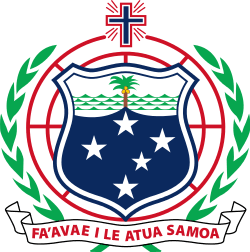Districts of Samoa
 |
| This article is part of a series on the politics and government of Samoa |
Samoa is made up of eleven itūmālō (political districts). These are the traditional eleven districts that were established well before European arrival. Each district has its own constitutional foundation (faavae) based on the traditional order of title precedence found in each district's faalupega (traditional salutations).
The capital village of each district administers and coordinates the affairs of the district and confers each districts' paramount title, amongst other responsibilities. For example, the District of A'ana has its capital at Leulumoega. The paramount title of A'ana is the TuiA'ana. The orator group which confers this title – the Faleiva (House of Nine) – is based at Leulumoega. This is also the same for the other districts. In the district of Tuamasaga, the paramount title of the district – The Malietoa title – is conferred by the FaleTuamasaga based in Afega.
Political districts
.png) | ||||||||||||||||||||||||
|---|---|---|---|---|---|---|---|---|---|---|---|---|---|---|---|---|---|---|---|---|---|---|---|---|
| Nr. | District | Capital | Area (km²) | Population (Census 2001) | ||||||||||||||||||||
| Upolu (including minor islands) | ||||||||||||||||||||||||
| 1 | Tuamasaga | Afega | 479 | 83,191 | ||||||||||||||||||||
| 2 | A'ana | Leulumoega | 193 | 20,167 | ||||||||||||||||||||
| 3 | Aiga-i-le-Tai1) | Mulifanua | 27 | 4,508 | ||||||||||||||||||||
| 4 | Atua2) | Lufilufi | 413 | 21,168 | ||||||||||||||||||||
| 5 | Va'a-o-Fonoti | Samamea | 38 | 1,666 | ||||||||||||||||||||
| Savai'i | ||||||||||||||||||||||||
| 6 | Fa'asaleleaga | Safotulafai | 266 | 12,949 | ||||||||||||||||||||
| 7 | Gaga'emauga3) | Saleaula | 223 | 7,108 | ||||||||||||||||||||
| 8 | Gaga'ifomauga | Aopo | 365 | 4,770 | ||||||||||||||||||||
| 9 | Vaisigano | Asau | 178 | 6,643 | ||||||||||||||||||||
| 10 | Satupa'itea | Satupa'itea | 127 | 5,556 | ||||||||||||||||||||
| 11 | Palauli | Vailoa | 523 | 8,984 | ||||||||||||||||||||
| Samoa | Apia | 2,831 | 176,848 | |||||||||||||||||||||
| 1) including islands Manono, Apolima and Nu'ulopa | ||||||||||||||||||||||||
| 2) including the Aleipata Islands and Nu'usafe'e Island | ||||||||||||||||||||||||
| 3) smaller parts also on Upolu (Salamumu (incl. Salamumu-Utu) and Leauvaa villages) | ||||||||||||||||||||||||
Exclaves of political districts
Note that several districts include multiple exclaves:
- Gaga'emauga: besides the main part on Savai'i, there are two small exclaves on Upolu (Salamumu (incl. Salamumu-Uta) and Leauva'a villages) – this is the only district with areas on both main islands
- Satupa'itea: consists of two separate areas on the south side of Savai'i
- Palauli: consists of two separate areas on the south side of Savai'i
- A'ana: besides the main part, there is a small exclave (Satuimalufilufi village)
- Va'a-o-Fonoti: besides the main part, there is a small exclave (Faleāpuna village)
- Aiga-i-le-Tai: includes the islands Manono, Apolima and Nu'ulopa
- Atua: includes the Aleipata Islands and Nu'usafe'e island
Electoral districts
The itūmālō are further subdivided in 41 faipule districts. They have no administrative function, but serve as electoral constituencies. The faipule districts are also used as regional units for statistics.
The faipule electoral districts are based loosely on the traditional sub-districts of the Itūmālō. For example, the faipule districts of Anoama'a West and Anoama'a East are based on the traditional sub-district of Anoama'a in the northern half of the Atua district.
Villages
At the local level, there are 265 villages. Additionally, there are some 45 villages the capital Apia is composed of. Apia does not have a common administration, the local power rests with the constituent villages.